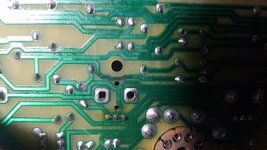7704A
Well-known member
I've seen amp builds in this sub-forum, so I'm assuming this is the place for repair logs too.
Anyhow, picked up a partly busted YCV80 in trade for a DIY tubescreamer clone I made (the stewmac one, with some durability tweaks). Sounds pretty good through my EVM cab. Sounded pretty crap through the original combo cab with 70/80's in it. Made that into a frankencab and flipped it, now I just have the stuff I care about, the actual amp.
First problem: Volume is way too low. Maxed clean channel volume, master nearly all the way up to be at what I'd call "daytime noodling volume". At 80W I should be dead, or nearly so, so that ain't right. Dirt channel is better, but not by much.
Second problem: Oscillations. Guess I can put off purchasing a theremin for now. Max volume and gain on dirt, and I can't push the treble past noon without it squealing. Turn on the boost, and I can play a medley with the oscillation by tweaking the tonestack knobs.
Third problem: No reverb.
Anyhow, picked up a partly busted YCV80 in trade for a DIY tubescreamer clone I made (the stewmac one, with some durability tweaks). Sounds pretty good through my EVM cab. Sounded pretty crap through the original combo cab with 70/80's in it. Made that into a frankencab and flipped it, now I just have the stuff I care about, the actual amp.
First problem: Volume is way too low. Maxed clean channel volume, master nearly all the way up to be at what I'd call "daytime noodling volume". At 80W I should be dead, or nearly so, so that ain't right. Dirt channel is better, but not by much.
Second problem: Oscillations. Guess I can put off purchasing a theremin for now. Max volume and gain on dirt, and I can't push the treble past noon without it squealing. Turn on the boost, and I can play a medley with the oscillation by tweaking the tonestack knobs.
Third problem: No reverb.

